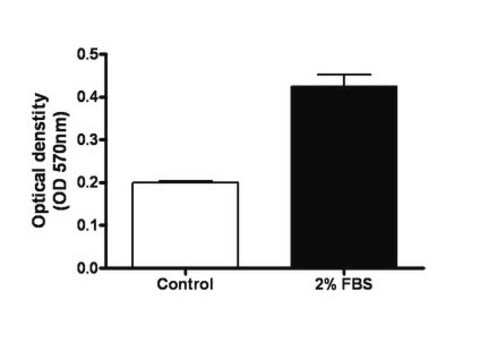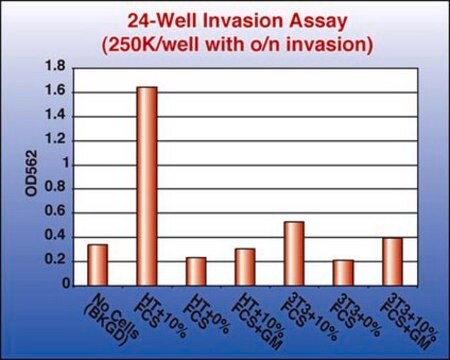17-10191
Cell Comb™ Scratch Assay
Synonym(s):
Cell layer wound repair assay
Sign Into View Organizational & Contract Pricing
All Photos(4)
About This Item
UNSPSC Code:
12352207
eCl@ss:
32161000
Recommended Products
manufacturer/tradename
Cell Comb™
Chemicon®
QCM
Quality Level
technique(s)
activity assay: suitable
cell based assay: suitable
western blot: suitable
shipped in
ambient
Related Categories
General description
Read our application note in Nature Methods!
Click Here!
Cell migration can be studied by a variety of methods, but the scratch assay remains a highly popular method due to the simplicity of the required materials, experimental setup, data collection and interpretation (Lian, C., et al., 2007; Cory, G., 2011). The scratch assay is typically initiated by scratching a confluent cell monolayer with a pipette tip to create a narrow wound-like gap. Shortly after wounding, the cells at the edge of the wound initiate a program to migrate into the gap, a process that continues until the gap has been completely repopulated with cells. Extent of wound closure is typically observed through light microscopy and protein expression patterns that occur during the wound healing process can be characterized by immunofluorescence.
Advances in understanding the repair mechanisms of wounded cell monolayers have been facilitated by the development of methods for performing the assay in multiwell plates. Such methods include delivering wounds to existing monolayers in the wells, or occlusion of the center of the well during monolayer formation to create a gap (Yarrow, J.C., et al., 2004; Simpson K.J., et al., 2008; Gough, W., et al., 2011). Each method then involves quantification of the extent of cell migration into the gap.
However, these methods are not optimal for biochemical analysis of the molecular events mediating wound repair. For example, the small scale of a basic pipette tip-derived wound provides insufficient and inadequate material for biochemical analysis. Using the same pipette tip to scratch a cell monolayer in a larger plate is tedious and irreproducible, and the proportion of migrating cells to quiescent cells is low. Several methods have been described to scale up the scratch assay by creating multiple wounds in cell monolayers but these methods require specialized tools (Turchi, L., et al., 2002; Lauder, H., et al., 1998).
EMD Millipore has developed the Cell Comb™ Scratch Assay to address the need for an easy-to-use tool for creating multiple scratch wounds. The patent pending Cell Comb<TMSYMBOL></TMSYMBOL> has been optimized to apply a high density field of scratches to maximize the area of wound edges, while leaving sufficient numbers of undamaged cells to migrate into the gap. This form of high density wounding creates a high proportion of migrating cells to quiescent monolayer cells, which permits sensitive detection of the biochemical events occurring, specifically in the migrating cell population.
Click Here!
Cell migration can be studied by a variety of methods, but the scratch assay remains a highly popular method due to the simplicity of the required materials, experimental setup, data collection and interpretation (Lian, C., et al., 2007; Cory, G., 2011). The scratch assay is typically initiated by scratching a confluent cell monolayer with a pipette tip to create a narrow wound-like gap. Shortly after wounding, the cells at the edge of the wound initiate a program to migrate into the gap, a process that continues until the gap has been completely repopulated with cells. Extent of wound closure is typically observed through light microscopy and protein expression patterns that occur during the wound healing process can be characterized by immunofluorescence.
Advances in understanding the repair mechanisms of wounded cell monolayers have been facilitated by the development of methods for performing the assay in multiwell plates. Such methods include delivering wounds to existing monolayers in the wells, or occlusion of the center of the well during monolayer formation to create a gap (Yarrow, J.C., et al., 2004; Simpson K.J., et al., 2008; Gough, W., et al., 2011). Each method then involves quantification of the extent of cell migration into the gap.
However, these methods are not optimal for biochemical analysis of the molecular events mediating wound repair. For example, the small scale of a basic pipette tip-derived wound provides insufficient and inadequate material for biochemical analysis. Using the same pipette tip to scratch a cell monolayer in a larger plate is tedious and irreproducible, and the proportion of migrating cells to quiescent cells is low. Several methods have been described to scale up the scratch assay by creating multiple wounds in cell monolayers but these methods require specialized tools (Turchi, L., et al., 2002; Lauder, H., et al., 1998).
EMD Millipore has developed the Cell Comb™ Scratch Assay to address the need for an easy-to-use tool for creating multiple scratch wounds. The patent pending Cell Comb<TMSYMBOL></TMSYMBOL> has been optimized to apply a high density field of scratches to maximize the area of wound edges, while leaving sufficient numbers of undamaged cells to migrate into the gap. This form of high density wounding creates a high proportion of migrating cells to quiescent monolayer cells, which permits sensitive detection of the biochemical events occurring, specifically in the migrating cell population.
Application
EMD Millipore′s patent pending Cell Comb™ Scratch Assay addresses the need for an easy-to-use tool for creating multiple scratch wounds, The Cell Comb has been optimized to apply a high density field of scratches to maximize the area of wound edges, while leaving sufficient numbers of undamaged cells to migrate into the gap. This form of high density wounding creates a high proportion of migrating cells to quiescent monolayer cells, which permits sensitive detection of the biochemical events occurring, specifically in the migrating cell population.
Research Category
Cell Structure
Cell Structure
This Cell Comb Scratch Assay has been optimized to apply a high density field of scratches to maximize the area of wound edges, while leaving sufficient undamaged cells to migrate into the gap.
Packaging
Enough Materials to Perform 6 Scratch Assays
Components
Cell Combs: Quantity of 6 individually packaged, disposable combs.
Rectangular Cell Culture Plates: Quantity of 6 individually packaged, cell culture-treated 86 mm x 128 mm plates.
The Cell Combs and Cell Culture Plates have been subjected to E-beam irradiation in order to minimize the possibility of contamination.
Rectangular Cell Culture Plates: Quantity of 6 individually packaged, cell culture-treated 86 mm x 128 mm plates.
The Cell Combs and Cell Culture Plates have been subjected to E-beam irradiation in order to minimize the possibility of contamination.
Storage and Stability
Store Cell Combs and Cell Culture Plates at room temperature. Use within 1 year from date of receipt.
Legal Information
CELL COMB is a trademark of Merck KGaA, Darmstadt, Germany
CHEMICON is a registered trademark of Merck KGaA, Darmstadt, Germany
Disclaimer
Unless otherwise stated in our catalog or other company documentation accompanying the product(s), our products are intended for research use only and are not to be used for any other purpose, which includes but is not limited to, unauthorized commercial uses, in vitro diagnostic uses, ex vivo or in vivo therapeutic uses or any type of consumption or application to humans or animals.
Storage Class Code
10 - Combustible liquids
Certificates of Analysis (COA)
Search for Certificates of Analysis (COA) by entering the products Lot/Batch Number. Lot and Batch Numbers can be found on a product’s label following the words ‘Lot’ or ‘Batch’.
Already Own This Product?
Find documentation for the products that you have recently purchased in the Document Library.
Richard L Klemke et al.
Methods in molecular biology (Clifton, N.J.), 1046, 203-218 (2013-07-23)
The cytoskeleton is fundamental to many cellular functions including cell proliferation, differentiation, adhesion, and migration. It is composed of actin, microtubules, intermediate filaments, and integrin cell surface receptors, which form focal adhesions with the extracellular matrix. These elements are highly
Shreeta Chakraborty et al.
The Journal of biological chemistry, 292(16), 6600-6620 (2017-02-27)
Endothelial nitric-oxide synthase (eNOS) and its bioactive product, nitric oxide (NO), mediate many endothelial cell functions, including angiogenesis and vascular permeability. For example, vascular endothelial growth factor (VEGF)-mediated angiogenesis is inhibited upon reduction of NO bioactivity both in vitro and
Our team of scientists has experience in all areas of research including Life Science, Material Science, Chemical Synthesis, Chromatography, Analytical and many others.
Contact Technical Service




